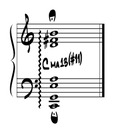String Quartet I
Eric Richards (1994)
Published by Eric Richards Music Services
On Tuesday, 20 September 2011, I had the great fortune of hearing my friends and colleagues in the world-class Grammy™ winning Chiara String Quartet perform my first String Quartet at the Kimball Recital Hall at the University of Nebraska. This piece was composed during the final phase of my doctoral work at the University of Maryland School of Music. I completed the work in 1994 and have waited eighteen years to hear the piece performed at such a high level...now that's Delayed Gratification (the composer's lot, I'm afraid.) I was amazed with the musicianship and clarity that they brought to this work...for a composer, it just doesn't get any better than this. Thank you, Chiara Quartet! Here are a few words about the piece:
String Quartet I is a three-movement work employing a synthesis of various compositional
techniques on global and local levels. As a composer working in genres of jazz,
vernacular, and concert music, my goal is to create music that draws effectively
from diverse styles without diluting or caricaturing any of them.
The large-scale structural form of this work follows the traditional scheme of a first and third movement generally characterized by a high level of activity. These outer movements are separated and contrasted by a second movement that is generally characterized by a sense of repose. The first movement is a set of four themes, each of which is developed in its own context. The final movement of Bela Bartok’s Sixth Quartet (“Mesto”) inspired the second movement. It begins with a reverent prayer-like chant that is developed in a series of four variations. The final movement is a highly rhythmic exploration of contrasts: structural contrasts between the movement’s own themes and fragments from the first two movements. The finale also explores textural contrasts between areas of highly active and relatively static harmonic rhythm.
Harmonically, the piece is organized via a series of symmetrical divisions of the octave and, while tonal, attempts to expand the sense of tonality by incorporating sections of bitonality and free atonality. The first movement can be heard as being centered on F, the second in “a minor”, and the third on Bb.
As I consider the span of eighteen years since I completed this work, I’m reminded that that any
success with which I’ve been blessed is largely due to the support of the family, friends and colleagues that God has placed in my life.
I am deeply grateful to:
• My Lord and Saviour Jesus Christ for His grace,
forgiveness, and sustenance
• My dear wife Lanelle for her love and care and my sons Josiah, Heath, Logan, and Gabriel for their love and
ability to help me "keep it real"
• My teachers Mark Wilson, Robert Gibson, Thomas Benjamin, Rabbi
Morris Moshe Cotel, Joseph Willcox
Jenkins, and John "Doc" Wilson
STRING QUARTET I (1994)........................Eric Richards
Movement I
STRING QUARTET I (1994)........................Eric Richards
Movement II
STRING QUARTET I (1994)........................Eric Richards
Movement III
